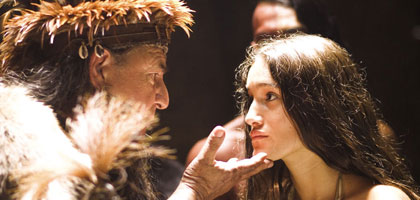Primary navigation


The story of Pocahontas is known to every US schoolchild - but Terrence Malick's feast for the senses brings new resonance to the tale. By Amy Taubin
Malick's Pocahontas (Q'Orianka Kilcher) yearns for Smith - like a teenage girl crazy in love - not merely because he is the dangerous, forbidden 'other', but also because she, and she alone, has a vision of the New World as the merging of two old cultures: that of the Native Americans, who had inhabited what would become the United States for as much as 18,000 years; and that of the English, whose original tiny enclave would quickly multiply into dozens and then hundreds of settlements. The New World opens with an invocation by Pocahontas, heard in voiceover amid bird calls: "Come spirit... Help us sing the story of our land... You are our mother... We rise out of the soul of you." We see a series of images of the natural world: sun glinting through tall trees; trees reflected in water; beneath the water, fish and humans swimming together; and, against this lush primeval landscape, a silhouetted Pocahontas, shot from an Eisensteinian low angle, standing with arms raised to the sky. The film then charts, with Malick's characteristic ellipses and rapturously beautiful images, Pocahontas' spiritual, emotional and intellectual journey, which reaches fulfilment in an English garden, where, as she plays with her son, we again hear her invoking the mother spirit in voiceover: "Mother, now I know where you live."
It is the intensity of Pocahontas' search for meaning and the curiosity and courage with which she pursues it that make The NewWorld so moving and ultimately tragic. Tragic because the viewer knows, with the advantage of historical hindsight, that her vision of the merging of two worlds died when she herself died in her early twenties, just as she and her family began the return voyage from England to Virginia. Over the course of the next 400 years the descendants of the original settlers savaged the land and all but annihilated Pocahontas' kin. When, at the end of The New World, the ship carrying Pocahontas' husband and son is shown sailing into Chesapeake Bay, it might as well be the vessel that carried Nosferatu to England.
Shot almost entirely in natural light with a moving camera (either handheld or Steadicam), the film is at once lively and meditative, precise and messy. It mixes carefully researched ethnographic detail with wildly romantic imagining. In form as well as content The New World is about hybridity, and nowhere is this more delicately and convincingly realised than in the score, which employs a lengthy orchestral passage from Wagner's Das Rheingold to express the excitement and yearning in the discovery of America, and the slow movement of Mozart's Piano Concerto No. 23 to capture the intensity and different yearning in the romance between Pocahontas and Smith. For Malick, beauty, in art as well as in nature, transcends history, and here he made me believe it most of the time.
The film suffers, however, from one fusion failure: Malick's attempt to introduce mass-market genre conventions into what is undeniably an art film. It was probably a mistake to have the actors playing Native Americans trained by an expert in dance ethnography because they move through the forest in the opening scenes as if they were in an Agnes De Mille ballet. Accurate or not, Pocahontas' thigh-high animal-skin tunics, which undoubtedly will show up on the catwalks this spring, sometimes make her look more like a Lolita figure than the character Malick reportedly described as "our original mother". It's also difficult to swallow Pocahontas' overnight mastery of English, or to overlook the colonialist implication of making English the default language - including for Pocahontas' voiceovers. And I wish that Malick, whose sexual politics have troubled me before, had been less casual in equating female agency with motherhood - that despite the fact that the idea of Pocahontas as "the mother of us all", to borrow from Gertrude Stein, moves me to tears.
Notwithstanding these quibbles and quarrels, The New World is a work of great intelligence, ambition and radiant beauty. And above all, it provides a memorable female hero, thanks to the collaboration between Malick and Kilcher, a 14-year-old novice with an exceptional emotional range. Like all of Malick's films, this one awakens the senses - not just sight and hearing, but touch and even smell. (In their first encounter the Native Americans sniff the settlers, and after that I kept wondering what Smith and Pocahontas smelled like, and whether her sense of smell changed after the settlers gave her a bath and dressed her in English clothes.)
But Malick's appeal is also to the viewer's analytic ability and understanding of structure. The film is anchored by three extended, visually and emotionally heightened set-pieces. At the mid-point of the narrative there is a battle between the Native Americans and the settlers that is even more brutal than anything in Malick's The Thin Red Line (1998); like the battle scenes in the earlier movie, it never climaxes but cycles and recycles until it's suddenly over. The other two sequences are mirror opposites that both involve the experience of coming fully to consciousness in a culture that is not one's own. About half an hour into the film Smith is captured by Powhatan's warriors and finds himself at the centre of a chaotic ritual from which Pocahontas supposedly saves him. In the immediate aftermath of this delirium he and Pocahontas have a romantic idyll, and for one brief moment he imagines that he could live with her in this Garden of Eden forever. But he quickly reverts to his callow, colonialist type (Colin Farrell is perfectly tuned to Smith's limitations), and the inevitable betrayal ensues. Then, towards the end of the film, Pocahontas is invited to the court of King James, and we see the strangeness of its rituals through her eyes. (In one of many visual rhymes the rounded high hat she wears echoes the shape of Powhatan's hat during Smith's initiation.) And later, in a manicured English garden that is the inverse of her wild North American paradise, she sees clearly enough to choose between false love and true. In his journal Smith describes Pocahontas as a high-spirited little girl who turned cartwheels when she visited us. Malick's Pocahontas turns her ecstatic cartwheel on a perfectly cut, flat green lawn, and with it she inscribes herself in our mind's eye forever.
Terrence Malick's The New World is a myth of origins set during the early years of Jamestown, Virginia, the first English settlement in North America, and concerning personages familiar to every schoolchild in the United States: Pocahontas, the Native American 'princess' who helped the settlers survive their first winter; Captain John Smith, the English explorer whose life Pocahontas may have saved; and John Rolfe, who married Pocahontas and with her had a son who became the wealthiest tobacco farmer in Virginia. (The details of the union between Pocahontas and Rolfe are usually omitted from the history primers, as they were from the 1995 Disney Pocahontas, since mixed marriages were soon criminalised in parts of the United States.) Very little information exists about the actual Pocahontas, and almost all of it comes from Smith's often contradictory journals and the writings of other settlers. It's not clear whether she and Smith had a romance or a sexual relationship - she was less than 12 when they met - or even that she saved his life. It does seem to be the case that she behaved with generosity towards the settlers, bringing them food and seed at the risk of alienating herself from her father, the great Algonquin chief Powhatan. While some Native American historians regard her actions as betrayal, for white America she is the principal icon of the Indian-as-pacifist.